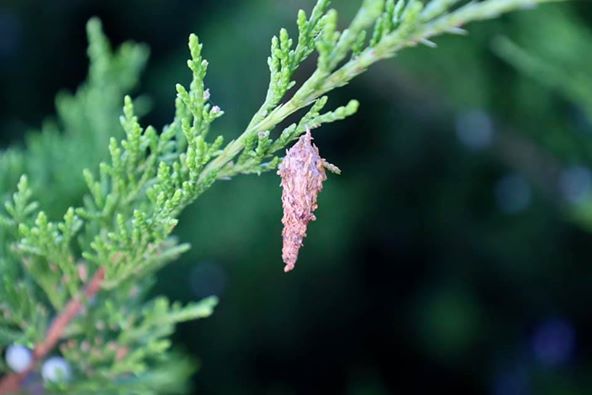Now is the Time to Control Bagworms!
What are Bagworms?
Bagworms are an invasive insect found in both rural and urban areas. A type of caterpillar that turns into a moth after the chrysalis stage, they live inside a spindle shaped bag made of silken threads and foliage. These protective bags blend in so well they look like part of the tree, which is why these invasive insects typically go unnoticed. Bagworms prefer evergreen trees and shrubs such as juniper, arborvitae, spruce, pine, and cedar, but will also attack deciduous trees. On evergreens, they eat away the buds and foliage causing branch tips to turn brown and die.

How do they form?
Bagworms hatch in early June from winterized eggs found in old bags. As soon as the young worms appear, they start to spin a new silk bag and prepare to mature. They secure these bags to branches as they transition into the adult stage. Although you may not notice the actual caterpillar, their camouflaged cocoons are easily identifiable upon inspection. Bagworms lay their eggs inside their bags where they remain throughout the winter. Did you know one single bag can hold up to 1,000 eggs?
When are they most active?
Bagworms are most active in July and August, which is when they cause the most damage. Bagworms partially crawl out of their bags to eat, causing significant damage to trees and shrubs. Once done, they retreat safely bag inside their bag. In fact, once inside their bag they are almost impossible to pull out. This is why early intervention is critical to saving your evergreen!

How do you treat for bagworms?
Bagworms mature in late August through early September. Once their bags reach 2+ inches long they usually cannot be killed by insecticide. The best way to control this invasive species is by spraying the foliage with insecticide after eggs have hatched and small bags are seen on the trees, typically mid-June to late July. Bagworms must consume the treated foliage for 1-2 days in order to consume a lethal dose of the insecticide. In order to determine if additional treatment is needed, inspect the infested plant approximately two weeks after the application for look live bagworms.

For more information or help treating your property for Japanese Beetles, call us today at (219) 261-2861 or email us at office@clarkscuttingedge.com.
Purdue University Extension and Entomology is also another great resource! Landscape & Ornamentals: Bagworms

